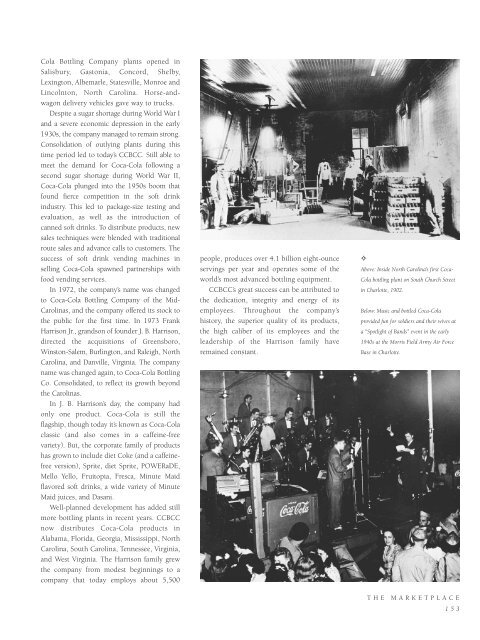Historic Charlotte
An illustrated history of the City of Charlotte and the Mecklenburg County area, paired with the histories of companies, families and organizations that make the region great.
An illustrated history of the City of Charlotte and the Mecklenburg County area, paired with the histories of companies, families and organizations that make the region great.
You also want an ePaper? Increase the reach of your titles
YUMPU automatically turns print PDFs into web optimized ePapers that Google loves.
Cola Bottling Company plants opened in<br />
Salisbury, Gastonia, Concord, Shelby,<br />
Lexington, Albemarle, Statesville, Monroe and<br />
Lincolnton, North Carolina. Horse-andwagon<br />
delivery vehicles gave way to trucks.<br />
Despite a sugar shortage during World War I<br />
and a severe economic depression in the early<br />
1930s, the company managed to remain strong.<br />
Consolidation of outlying plants during this<br />
time period led to today’s CCBCC. Still able to<br />
meet the demand for Coca-Cola following a<br />
second sugar shortage during World War II,<br />
Coca-Cola plunged into the 1950s boom that<br />
found fierce competition in the soft drink<br />
industry. This led to package-size testing and<br />
evaluation, as well as the introduction of<br />
canned soft drinks. To distribute products, new<br />
sales techniques were blended with traditional<br />
route sales and advance calls to customers. The<br />
success of soft drink vending machines in<br />
selling Coca-Cola spawned partnerships with<br />
food vending services.<br />
In 1972, the company’s name was changed<br />
to Coca-Cola Bottling Company of the Mid-<br />
Carolinas, and the company offered its stock to<br />
the public for the first time. In 1973 Frank<br />
Harrison Jr., grandson of founder J. B. Harrison,<br />
directed the acquisitions of Greensboro,<br />
Winston-Salem, Burlington, and Raleigh, North<br />
Carolina, and Danville, Virginia. The company<br />
name was changed again, to Coca-Cola Bottling<br />
Co. Consolidated, to reflect its growth beyond<br />
the Carolinas.<br />
In J. B. Harrison’s day, the company had<br />
only one product. Coca-Cola is still the<br />
flagship, though today it’s known as Coca-Cola<br />
classic (and also comes in a caffeine-free<br />
variety). But, the corporate family of products<br />
has grown to include diet Coke (and a caffeinefree<br />
version), Sprite, diet Sprite, POWERaDE,<br />
Mello Yello, Fruitopia, Fresca, Minute Maid<br />
flavored soft drinks, a wide variety of Minute<br />
Maid juices, and Dasani.<br />
Well-planned development has added still<br />
more bottling plants in recent years. CCBCC<br />
now distributes Coca-Cola products in<br />
Alabama, Florida, Georgia, Mississippi, North<br />
Carolina, South Carolina, Tennessee, Virginia,<br />
and West Virginia. The Harrison family grew<br />
the company from modest beginnings to a<br />
company that today employs about 5,500<br />
people, produces over 4.1 billion eight-ounce<br />
servings per year and operates some of the<br />
world’s most advanced bottling equipment.<br />
CCBCC’s great success can be attributed to<br />
the dedication, integrity and energy of its<br />
employees. Throughout the company’s<br />
history, the superior quality of its products,<br />
the high caliber of its employees and the<br />
leadership of the Harrison family have<br />
remained constant.<br />
✧<br />
Above: Inside North Carolina’s first Coca-<br />
Cola bottling plant on South Church Street<br />
in <strong>Charlotte</strong>, 1902.<br />
Below: Music and bottled Coca-Cola<br />
provided fun for soldiers and their wives at<br />
a “Spotlight of Bands” event in the early<br />
1940s at the Morris Field Army Air Force<br />
Base in <strong>Charlotte</strong>.<br />
THE MARKETPLACE<br />
153
















